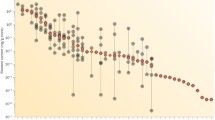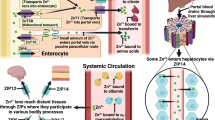Abstract
In recent years, the role of trace elements in lithogenesis has received steadily increasing attention. It is well documented that some trace elements can influence the morphology and speed of the crystallization process. Zinc has been found in significant amounts in calcium stones relative or organic stones (uric acid and cystine), probably substituting calcium in crystals because of their similarity in charge and size. High Zn levels are present in carbapatite of Randal’s plaques suggesting that zinc could promote calcium phosphate deposition in the medullar interstitium. Large-scale epidemiological studies have found an association of increased dietary zinc intake with increased risk of nephrolithiasis in adults but not in adolescents. Most studies examining urinary zinc levels in adults have reported increased urinary Zn excretion in stone formers. In an experimental model of organic crystal formation produced by silencing xanthine dehydrogenase in Drosophila fly, maneuvers that reduce Zn excretion have shown to reduce crystal formation in the lumen of the Malpighian tubules. This is curious because this is not a model of calcium stone formation. Finally, zinc supplementation has been associated with increased admissions for urinary lithiasis in men, but no change in calcium stone formation in children. Perhaps, some of these contradicting findings can be explained in part by the in vitro effect of zinc on the type and amount of calcium phosphate formed: At low concentrations, Zn inhibited the crystal growth of dicalcium phosphate dihydrate, octacalcium phosphate, and apatite, and at higher concentrations, it promoted the formation of amorphous calcium phosphate. Thus, further studies are needed to see whether manipulation of Zn metabolism can inhibit calcium stone formation.
Similar content being viewed by others
References
Shoag J, Tasian GE, Goldfarb DS, Eisner BH (2015) The new epidemiology of nephrolithiasis. Adv Chronic Kidney Dis 22(4):273–278
Moe OW (2006) Kidney stones: pathophysiology and medical management. Lancet 367(9507):333–344
Hofbauer J, Steffan I, Höbarth K, Vujicic G, Schwetz H, Reich G, Zechner O (1991) Trace elements and urinary stone formation: new aspects of the pathological mechanism of urinary stone formation. J Urol 145(1):93–96
Atakan IH, Kaplan M, Seren G, Aktoz T, Gül H, Inci O (2007) Serum, urinary and stone zinc, iron, magnesium and copper levels in idiopathic calcium oxalate stone patients. Int Urol Nephrol 39(2):351–356
Welshman SG, McGeown MG (1972) A quantitative investigation of the effects on the growth of calcium oxalate crystals on potential inhibitors. Br J Urol 44(6):677–680
Sutor DJ (1969) Growth studies of calcium oxalates in the presence of various ions and compounds. Br J Urol 41:171–178
Bazin D, Chevallier P, Matzen G, Jungers P, Daudon M (2007) Heavy elements in urinary stones. Urol Res 35(4):179–184
Keshavarzi B, Yavarashayeri N, Irani D, Moore F, Zarasvandi A, Salari M (2015) Trace elements in urinary stones: a preliminary investigation in Fars province, Iran. Environ Geochem Health 37(2):377–389
Hannache B, Boutefnouchet A, Bazin D, Daudon M, Foy E, Rouzière S, Dahdouh A (2015) Presence and role of trace elements in urinary calculi. Prog Urol 25(1):22–26
Carpentier X, Bazin D, Combes C, Mazouyes A, Rouzière S, Albouy PA, Foy E, Daudon M (2011) High Zn content of Randall’s plaque: a μ-X-ray fluorescence investigation. J Trace Elem Med Biol 25(3):160–165
Tang J, McFann K, Chonchol M (2012) Dietary zinc intake and kidney stone formation: evaluation of NHANES III. Am J Nephrol 36:549–553
Turney BW, Appleby PN, Reynard JM, Noble JG, Key TJ, Allen NE (2014) Diet and risk of kidney stones in the Oxford cohort of the European Prospective Investigation into Cancer and Nutrition (EPIC). Eur J Epidemiol 29(5):363–369
Tasian GE, Ross ME, Song L, Grundmeier RW, Massey J, Denburg MR, Copelovitch L, Warner S, Chi T, Killilea DW, Stoller ML, Furth SL (2017) Dietary zinc and incident calcium kidney stones. J Urol 197(5):1342–1348
Komleh K, Hada P, Pendse AK, Singh PP (1990) Zinc, copper and manganese in serum urine and stones. Int Urol Nephrol 22(2):113–118
Trinchieri A, Mandressi A, Luongo P, Rovera F, Longo G (1992) Urinary excretion of citrate, glycosaminoglycans, magnesium and zinc in relation to age and sex in normal subjects and in patients who form calcium stones. Scand J Urol Nephrol 26(4):379–386
Ozgurtas T, Yakut G, Gulec M, Serdar M, Kutluay T (2004) Role of urinary zinc and copper on calcium oxalate stone formation. Urol Int 72(3):233–236
Chasapis CT, Spiliopoulou CA, Loutsidou AC, Stefanidou ME (2012) Zinc and human health: an update. Arch Toxicol 86(4):521–534
Hambidge M, Krebs NF (2001) Interrelationships of key variables of human zinc homeostasis: relevance to dietary zinc requirements. Annu Rev Nutr 21:429–452
King JC, Shames DM, Woodhouse LR (2000) Zinc homeostasis in humans. J Nutr 130:1360S–1366S
Hambidge KM, Miller LV, Krebs NF (2011) Physiological requirements for zinc. Int J Vitam Nutr Res 81:72–78
Gaither LA, Eide DJ (2001) Eukaryotic zinc transporters and their regulation. Biometals 14(3–4):251–270
Kambe T (2011) An overview of a wide range of functions of ZnT and Zip zinc transporters in the secretory pathway. Biosci Biotechnol Biochem 75(6):1036–1043
Lichten LA, Cousins RJ (2009) Mammalian zinc transporters: nutritional and physiologic regulation. Annu Rev Nutr 29(1):153–176
Cousins RJ, Liuzzi JP, Lichten LA (2006) Mammalian zinc transport, trafficking, and signals. J Biol Chem 281(34):24085–24089
Liuzzi JP, Cousins RJ (2004) Mammalian zinc transporters. Annu Rev Nutr 24(1):151–172
Rungby J (2010) Zinc, zinc transporters and diabetes. Diabetologia 53(8):1549–1551
Eide DJ (2012) An ‘inordinate fondness for transporters’ explained? Sci Signal 5(210):5
Chi T, Kim MS, Lang S, Bose N, Kahn A, Flechner L, Blaschko SD, Zee T, Muteliefu G, Bond N, Kolipinski M, Fakra SC, Mandel N, Miller J, Ramanathan A, Killilea DW, Brückner K, Kapahi P, Stoller ML (2015) A Drosophila model identifies a critical role for zinc in mineralization for kidney stone disease. PLoS ONE 10(5):e0124150
Dow JAT, Romero MF (2010) Drosophila provides rapid modeling of renal development, function, and disease. AJP Renal Physiol 299:F1237–F1244
Wang X, Wu Y, Zhou B (2009) Dietary zinc absorption is mediated by ZnT1 in Drosophila melanogaster. FASEB J 23:2650–2661
Yepiskoposyan H, Egli D, Fergestad T, Selvaraj A, Treiber C, Multhaup G, Georgiev O, Schaffner W (2006) Transcriptome response to heavy metal stress in Drosophila reveals a new zinc transporter that confers resistance to zinc. Nucleic Acids Res 34:4866–4877
Johnson AR, Munoz A, Gottlieb JL, Jarrard DF (2007) High dose zinc increases hospital admissions due to genitourinary complications. J Urol 177(2):639–643
Yousefichaijan P, Cyrus A, Dorreh F, Rafeie M, Sharafkhah M, Frohar F, Safi F (2015) Oral zinc sulfate as adjuvant treatment in children with nephrolithiasis: a randomized, double-blind, placebo-controlled clinical trial. Iran J Pediatr 25(6):e1445
LeGeros RZ, Bleiwas CB, Retino M, Rohanizadeh R, LeGeros JP (1999) Zinc effect on the in vitro formation of calcium phosphates: relevance to clinical inhibition of calculus formation. Am J Dent 12(2):65–71
Letavernier E, Vandermeersch S, Traxer O, Tligui M, Baud L, Ronco P, Haymann JP, Daudon M (2015) Demographics and characterization of 10,282 Randall plaque-related kidney stones: A new epidemic? Medicine (Baltimore) 94(10):e566
Chen YH, Liu HP, Chen HY, Tsai FJ, Chang CH, Lee YJ, Lin WY, Chen WC (2011) Ethylene glycol induces calcium oxalate crystal deposition in Malpighian tubules: a Drosophila model for nephrolithiasis/urolithiasis. Kidney Int 80(4):369–377
Author information
Authors and Affiliations
Corresponding author
Ethics declarations
Conflict of interest
Author declares that he has no conflict of interest.
Ethical approval
This article does not contain any studies with human participants or animals performed by the author.
Rights and permissions
About this article
Cite this article
Negri, A.L. The role of zinc in urinary stone disease. Int Urol Nephrol 50, 879–883 (2018). https://doi.org/10.1007/s11255-017-1784-7
Received:
Accepted:
Published:
Issue Date:
DOI: https://doi.org/10.1007/s11255-017-1784-7




